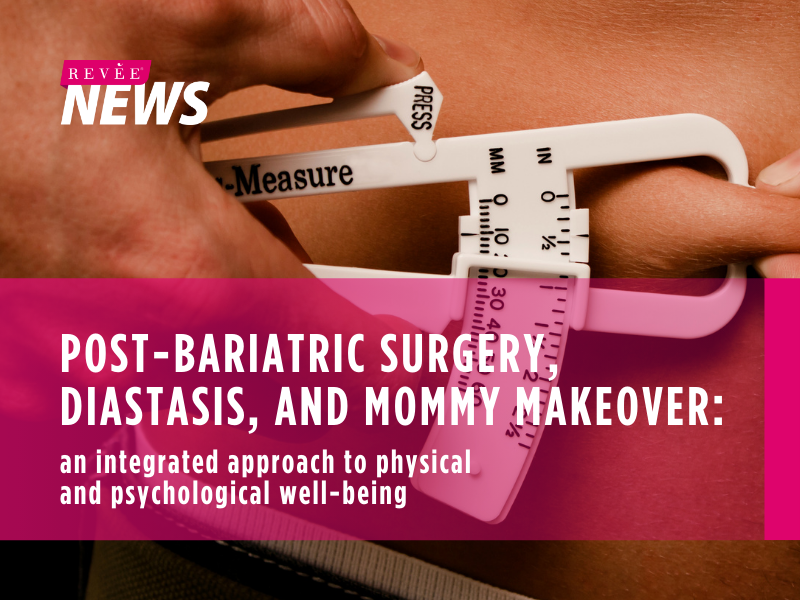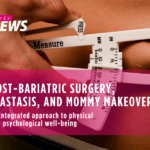Revée pills
Post-Bariatric surgery, diastasis, and mommy makeover: an integrated approach to physical and psychological well-being

Over the years, weight loss has been a central topic in Revée News, encompassing a wide range of issues from obesity to physical recovery after motherhood. In this article, we aim to provide a comprehensive overview, combining insights from experts, associations, and patients, to discuss post-bariatric surgery, abdominal diastasis, and lymphedema management. This collective narrative blends science and humanity to explore how modern medicine can enhance not just physical health but also psychological well-being.
Post-bariatric surgery is a critical step for patients embarking on a physical and psychological transformation after weight-loss procedures. However, body contouring is not solely about aesthetics. Addressing conditions like abdominal diastasis and lymphedema requires innovative approaches, advanced techniques, and a supportive network of professionals. Within this context, the contributions of minimally invasive surgery and dedicated associations highlight the importance of an integrated and multidisciplinary approach to patients’ overall well-being.
Post-Bariatric surgery: physical and psychological transformation
Post-bariatric surgery goes beyond removing excess skin, addressing functional improvements as well. As Professor Paolo Persichetti, Director of the Complex Operational Unit and the School of Specialization in Plastic, Reconstructive, and Aesthetic Surgery at the Campus Bio-Medico University of Rome, explains:
«This procedure not only restores aesthetic appearance but also emotional well-being. It’s not just about removing excess skin but also addressing functional goals».
Post-Bariatric surgery: restoring physical form and quality of life
These procedures require a multidisciplinary approach and continuous support to ensure long-term success. One of the most significant outcomes is the positive impact on quality of life. Dr. Jacopo Frattaroli, specialist in Plastic, Reconstructive, and Aesthetic Surgery, PhD at “Sapienza” University of Rome, states:
«Patients regain their body image, improving self-esteem and overall quality of life».
Body contouring and mommy makeover: shaping the body and addressing diastasis
The Mommy Makeover combines procedures designed to address physical changes caused by pregnancy. Dr. Vito Toto, specialist in plastic, reconstructive, and aesthetic surgery at Campus Bio-Medico of Rome, explains that after one or more pregnancies, the breasts and abdomen often undergo significant transformations. Common procedures in a Mommy Makeover include breast surgery (augmentation, reduction, mastopexy, or mastopexy with implants) and abdominoplasty to correct diastasis of the rectus muscles or address umbilical hernias.
Abdominal diastasis, a separation of the rectus abdominal muscles, can occur following bariatric surgeries or pregnancies.
«An abdominoplasty may be necessary when there’s a significant amount of excess skin – Dr. Toto explains -. A mini-abdominoplasty is an option for lesser skin removal. In most cases, liposuction—particularly around the hips—is also performed. Additional liposuction may target the thighs or even the knees».
Professor Valerio Cervelli highlights:
«The typical body contouring patient is someone who has experienced significant weight loss, often due to bariatric surgery or pregnancy. In cases of multiple or difficult pregnancies, women may face severe physical changes, including abdominal diastasis, requiring comprehensive corrections».
The power of professional networks
The association Diastasi Italia, founded in 2015, provides free, accurate information to those affected by abdominal diastasis. Claudia Fabretti, President of Diastasi Italia and a physiotherapist and osteopath, describes the organization:
«Diastasi Italia is a network of professionals, divided by region, who specialize in abdominal diastasis, from physiotherapists to athletic trainers, nutritionists, and surgeons. This enables men and women to access proper evaluations for this condition».
The group’s Facebook pages—Diastasi Italia Official Group (for women) and Diastasi Uomo (for men)—combat myths and misinformation, guiding patients toward the appropriate solutions.
Minimally invasive solutions in abdominal wall surgery
Abdominal wall surgery is crucial for treating conditions affecting the abdominal wall. In recent years, the number of related procedures has increased significantly. As Dr. Alessandra Saputelli, general surgeon and medical director at the General and Emergency Surgery Unit of San Filippo Neri Hospital, notes:
«In 2022, approximately 17,000 patients were treated for abdominal wall pathologies».
Robotic and laparoscopic surgery are opening new avenues in treating these conditions. These minimally invasive approaches not only deliver satisfactory clinical outcomes but also provide significant psychological benefits for patients.
«For umbilical or epigastric hernias without rectus diastasis, we can use either open or laparoscopic techniques – explains Dr. Saputelli -. Robotic surgery is also applied to abdominal wall conditions, including umbilical and epigastric hernias, as well as laparoceles. This approach, like laparoscopic surgery, reduces postoperative complications more effectively than it reduces operative time».
This integrated approach underscores the importance of combining innovative techniques, patient education, and professional networks to support individuals on their journey to recovery.




































